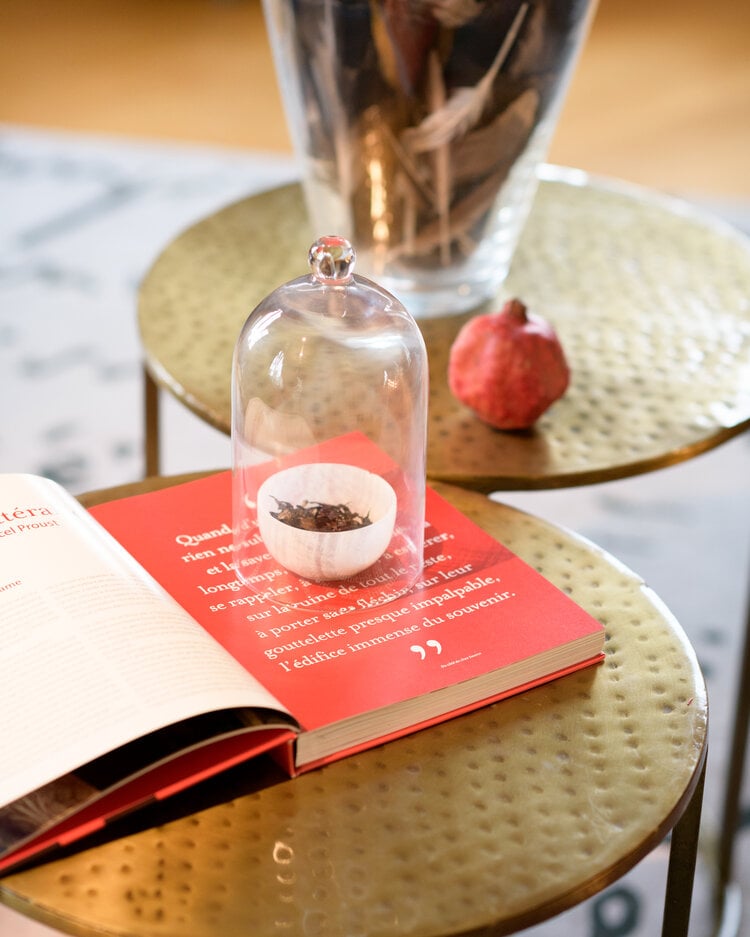An interview with scent specialist, Emmanuelle Grau-Bretin, founder and director of the Neuchâtel-based olfactory design center, Flacon & Molecule. Working at the crossroads of brain science, art, design and the senses, Emmanuelle shares her views on the importance of creating the right scent signature in order to form a unique and memorable bond with your clientele. Let's not forget that after a year of restrictions, finding a way to return to the human senses is now more important than ever.
Have you ever entered a hotel room, lobby or spa and not liked the smell? No matter how splendid the decor and comfortable the setting, the experience was likely to have been marred by an unforgettable annoyance that probably impacted whether you chose to ever return to the same establishment again. Like an inappropriate playlist playing heavy metal during a fine dining experience, getting the smells wrong in a hotel environment can suddenly become an elephant in the room for your guests.
From surgeon to stylist, it was Emmanuelle's aspiration to combine well-being and aesthetics that brought her to the mission of olfactory design and sensorial styling. More than just creating nice tailor-made perfumes, her work is as much part of the branding process as the design of a company's logo and website. Subtle psychology and a highly personalized approach is what distinguishes her method of defining the essential expression of a brand and its accompanying olfactory avatar. The sweet spot, according to Emmanuelle, lies in finding the right harmony between brand identity and client target.
1. What is it about a scent that creates such a lasting effect on memory and emotions?
EGB: Stimulation of the sense of smell, or the olfactory epithelium, has the ability to directly reach the limbic system - the area of the brain that processes instinctual emotions and behaviors. From there, the information is stored in the cerebral cortex, the seat of memory. It is this neurophysiological peculiarity that explains the direct link between smell, memory and emotional reaction. This is also what makes it possible to understand why emotion always precedes the conscious recognition of a smell.
Odor, being a privileged medium for installing, storing and recalling memories linked to a particular experience, is therefore an interesting branding tool. A scent that is remembered has not only been smelled but also felt - since it communicates directly with the emotional system of our brain. The more intense the emotion-scent connection, the greater the imprint in the memory.
In addition, beyond the ability to travel in space and time, the olfactory experience allows you to be more responsive and alert to the present moment. Smell is, in my opinion, one of our most powerful means of connection to the physical world and to our ability to observe the environment from the body. Its stimulation makes one more likely to "savor" the proposed experience and, therefore, to remember it later. Our unconscious memory has not only registered a smell with great precision, but has marked it as a special moment in our life at the moment of perception.
It is interesting to know that with a scent, the memory of past experience stored in our autobiographical memory can return without our conscious will intervening. Coming across a smell from the past "again" allows the memory to return involuntarily and effortlessly to either the event or the time associated with it.
This last point helps to understand the value of olfactotherapy in helping people with memory disorders. Smells facilitate the retrieval of memories and allow the conscious reappearance of a past event with more spontaneity.
2. What do you take into account when designing a scent for a brand?
EGB: The particularity of my approach is to be introspective. I like to capture what makes this brand unique by studying its history, philosophy, values, purpose and style. If the brand has a visual identity, then I am inspired by its color, texture, atmosphere and layout of its spaces. Its olfactory signature must resonate with all aspects of the brand in order to tell the right story and to be on the same wavelength.
The visual and olfactory identity must enhance each other in order to create a distinctive sensory universe, coherent and aligned with the brand's DNA. I'm also trying to understand who the brand is talking to: Who is its ideal client, what does it want to communicate and what emotional experience does it want to offer? And lastly, how does the brand want to be remembered?
3. What impact can a scent have in a hospitality space and the customer?
EGB: The olfactory experience will make the customer more attentive to the present moment and inclined to savor it. Olfactory marketing studies compare scented and unscented retail spaces. Customers in scented spaces are happy to stay there longer and therefore make more purchases.
Also, what I personally find exciting is that by "sensitizing" the customer's experience, you make the moment both unique and more familiar. Not only does this distinguish the experience in his/her memory, but it also promotes the creation of a bond based on loyalty and belonging.
At the same time, since smells are important "mood influencers", it is interesting to use them to promote a certain state of being: comfort, serenity, harmony. As said above, it is important to understand what the customer comes to experience in this specific place.
 Image Credits : Flacon & Molecule
Image Credits : Flacon & Molecule
4. How can a scent be used effectively in a hotel environment?
EGB: Offering personalized solutions, I like to understand what the specific intentions of the hotel or the venue are. Indeed, the olfactory signature can underline an atmosphere, a decoration or a setting. In a reception area, for example, where you want to highlight a visual identity and a style, then the scent can help to reinforce that message.
Scents can also make it possible to “olfactively” separate spaces according to their role. Here, in addition to stylistic enhancement, it is the mood influencing power of olfactory art that is developed. For example, one scent could be dedicated to reception and meeting rooms, and another to relaxation and well-being spaces.
It is also interesting to understand whether the hotel establishment wishes to allow its client to continue their olfactory experience at home. By creating objects from their scent signature that customers can take with them or receive at home, the hotel maintains its bond. These fragrant objects can be various: candles, ceramics, sprays for rooms and sheets. It is also possible to create scented packaging or stationery (e.g., scented greeting cards). These gestures allow the customer to relive at home the experience had during their stay. This goes some way to making the guest feel privileged and unique in the eyes of the hotel establishment, further strengthening the bond of loyalty.
5. Do you agree that the use of scent is especially linked to the luxury "high end" sector?
EGB: As with everything, there is high and low-end spectrum even in perfumes. Knowing how to use them in a refined, consistent and specific way is not so common. This is why I personally think that if you want to enrich your brand identity or your professional environment with an olfactory intervention, then it is good to call on qualified people with the right know-how. I have seen a lot of inconsistency, in my opinion, with the consequence of devaluing the brands or companies concerned. I am more of the view that it is better to do nothing than to do things badly or halfway.
Beyond the notion of "high-end", I think that the choice to accompany a brand identity with a fragrance must be intentional and convey a real desire for enhancement. My dearest wish is ultimately that both the hotel establishment with which I collaborate and its end customer will feel uplifted by the olfactory experience.
Fragrance in the EHL curriculumThe EHL campus in Passugg (Swiss School of Tourism & Hospitality) has worked on the theme of fragrance in hospitality as part of a student project. The idea was to give students an understanding of the importance of scent in the hotel industry by allowing them to develop one themselves for the Passugg campus. The project came under the heading of "Affective Physical Experience" with the aim of exploring sensory marketing. The scent is now used in the school hotel and is also available as a give-away. The SSTH fragrance should:
Use of fragrance:
The new curriculum starting in autumn 2021 plans to address the role of the five senses in the hotel industry. |





